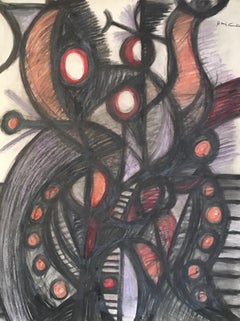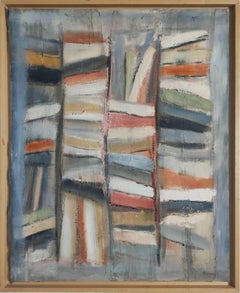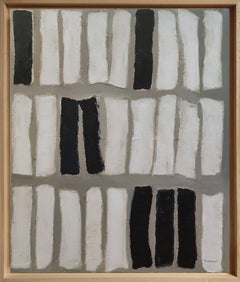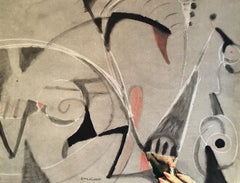Herve Carrier Art
Hervé Carrier was born October 13, 1932 in Martigues (Bouches-du-Rhône). He interrupted his studies at age 15 and painted his first painting. Apprentice to Merlin-Gerin, and unhappy with his professional occupations, he cultivated a frantic absenteeism that allowed him to discover the museum. His first art book was a Dufy monograph with a view of the old port of Marseille dated to 1925. He then discovered modern painting with the fascicles published by Hazan in the early 1950s. His first exhibition took place in Grenoble in February 1957, his work was then in the form of non-figurative varnished gouaches freely inspired by Fernand Léger.
In 1963, Carrier accepted a job as a caretaker at the Museum of Painting in Grenoble, after 1970 the management of the reserves became his main activity at the museum. In 1961, he constructed sculptures made of poor materials — often fragments of objects, sometimes articulated. He especially sought in these montages a possibility of a playful approach to the sculpture with which he tried to reconcile his interest for the primitive arts. As a result of the ideological effervescence of the moment in 1968, he stopped any individual production for a group activity with Dody and Unal. They participated in the sixth Biennial of Paris, the exhibition Impact 2 at the Ceret Museum in 1972 just before the dissolution of the group. The following year, he began a series of paintings composed of fragments of works of masters of modern art approximately reproduced and arbitrarily collected, which allowed him to reconcile appropriation and misappropriation into a caustic tribute to the influence of the masters.
In 1981, Carrier returned to sculpture long neglected because of a lack of space. This space was in the cellars of the museum where he worked only part-time and then he looked for material from scrap dealers.
"My sculptures are static” he wrote, “fixed of course, but the pieces are twisted, rounded, follow a rhythm, move and turn. It's an expression of freedom, the unpredictable."
From 1983–92, Carrier’s pictorial works were humorous allusions to traditional iconography — Biblical scenes, still lifes, landscapes are the main themes of compositions of a very effective incongruity. "I start from a character, an attitude or a silhouette seen in an old painting. The quote is no longer really one. It's a kind of stimulation to paint."
In 1993, finally retired, Carrier moved to Veynes (Hautes-Alpes). His new studio allowed him to continue to practice sculpture, painting and drawing in the best conditions until his death in 2000.
Mid-20th Century Abstract Herve Carrier Art
Oil
21st Century and Contemporary Abstract Expressionist Herve Carrier Art
Oil
21st Century and Contemporary Abstract Expressionist Herve Carrier Art
Oil
2010s Abstract Impressionist Herve Carrier Art
Oil, Cardboard
Natalya Mougenot Impressionist Oil Painting Cardboard "The Symbiosis of Waterlilies and Lotus", 2023
2010s Abstract Herve Carrier Art
Oil, Acrylic
2010s Abstract Herve Carrier Art
Oil, Acrylic
21st Century and Contemporary Abstract Geometric Herve Carrier Art
Oil
2010s Abstract Herve Carrier Art
Oil, Acrylic
2010s Abstract Impressionist Herve Carrier Art
Oil
21st Century and Contemporary Abstract Expressionist Herve Carrier Art
Oil
2010s Abstract Herve Carrier Art
Canvas, Cotton Canvas, Mixed Media, Oil, Spray Paint, Acrylic
2010s Abstract Expressionist Herve Carrier Art
Canvas, Oil
2010s Abstract Impressionist Herve Carrier Art
Oil, Resin
Mid-20th Century Abstract Herve Carrier Art
Oil



